As a 40-year-old considered the greatest ever at his craft, the possessor of the latest Super Bowl MVP award and five Lombardi Trophies, Tom Brady entered this year with little reason to modify his performance. In a ranking of humans with the least incentive to change, in fact, Gisele’s husband would rank somewhere near the top.
And yet a close inspection of Brady during another MVP-caliber year reveals a quarterback amid personal evolution. Brady burnished his legend with short, precise passes to quicksilver receivers darting over the middle. He became a master of manipulating defenses and spewing quick throws. This year Brady has turned gunslinger, heaving bombs with greater frequency than at any point in his 18-year career.
Brady’s penchant for deep throws is nothing short of a stylistic transformation. Last year he attempted 49 passes thrown at least 20 yards in the air all season, according to data tracked by Pro Football Focus, which uses the 20-yard barrier to define deep passes. This season he’s already tossed 40 deep passes, the most in the NFL.
Brady has thrown 15.3 percent of his passes more than 20 yards in the air, the third-highest total in the league behind Deshaun Watson and Tyrod Taylor. His previous career high came in 2006 at 13.4 percent. In the past four seasons, Brady’s frequency throwing long had ranged between 10.5 and 11.3 percent, ranking in the bottom half of the league. Compared to his peers, Brady relied heavily on short passes. This season he’s chucking it deep.
Last season, according to the NFL’s Next Gen Stats, Brady’s average target was 8.6 yards downfield, which put him in the middle of the pack, just below average among NFL quarterbacks. This season he’s averaging 10.1 yards in the air per attempt, fifth in the NFL.
The shift has not diminished Brady’s excellence or efficiency. He’s completed 18 deep passes, most in the NFL, despite two drops. His 8.4 yards per attempt is the second-best total of his career, and he’s completing 66.8 percent of his passes, the third-highest total of his career.
The sudden change has come in response to several factors, starting with receiving personnel. When Julian Edelman suffered a season-ending injury in preseason, Brady lost one of the option-route artists in the NFL, his favorite target on quick passes.
The loss of Edelman came as the Patriots added Brandin Cooks, who gave Brady his best outside deep threat since Randy Moss. Brady’s average pass to Cooks has traveled 14.3 yards, longer than any Patriots receiver last season. Edelman’s loss also meant more targets for Chris Hogan, a long strider whose best routes are run up the field.
Defensive schemes also played a role. More teams are using the blueprint Kansas City Chiefs defensive coordinator Bob Sutton provided in Week 1, gumming up the middle of the field and forcing Brady to make deep throws down the sideline. Brady has responded by showing it doesn’t work.
As a young quarterback, the biggest knock on Brady was his ability to throw deep. At 40, amazingly, he’s doing it better than ever.
Meanwhile, health and continuity on New England’s offensive line has meant more time in the pocket for Brady to let deep patterns develop. Five offensive linemen – Nate Solder, Joe Thuney, David Andrews, Shaq Mason and Marcus Cannon – have all started at least 21 of 23 games since the start of last season. Under esteemed offensive line coach/guru Dante Scarnecchia, it has become one of the best lines in football.
Brady became the best ever playing a specific style, and now he’s the best in the NFL playing quarterback a different way. That he’s a marvel is something nobody needed to be reminded of. His ability to adapt and improve, at an age when most every other quarterback had retired, with a legacy already secure, only reinforces his singularity.
Send questions/comments to the editors.



Success. Please wait for the page to reload. If the page does not reload within 5 seconds, please refresh the page.
Enter your email and password to access comments.
Hi, to comment on stories you must . This profile is in addition to your subscription and website login.
Already have a commenting profile? .
Invalid username/password.
Please check your email to confirm and complete your registration.
Only subscribers are eligible to post comments. Please subscribe or login first for digital access. Here’s why.
Use the form below to reset your password. When you've submitted your account email, we will send an email with a reset code.